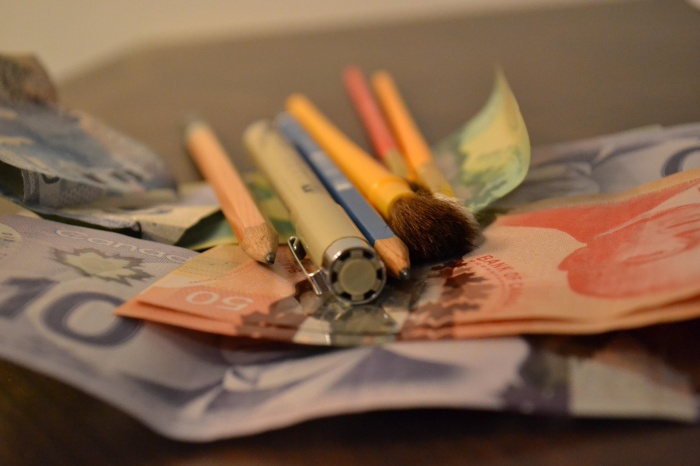What do professional artists do, exactly? Do they spend their days sitting cross-legged in a loft-style brick apartment in the city, wearing smocks and throwing paint on their canvases? And can they really make thousands of dollars for each painting?
As a designer and photographer unfamiliar with the scene in Victoria, I found myself intrigued by questions that are so often asked, but seldom examined.
Tracking down Camosun alumni and profs, as well as others working as artists, I tried to get to the bottom of what exactly it means to be a working artist, as well as what it’s like balancing art with commerce, and theory with reality.
Making it in Victoria
Caleb Speller studied in the Visual Arts program at Camosun and has been working as an artist for close to a decade. After speaking with him and his professors, it’s clear that Speller’s wisdom and innovative personality inspires the untiring originality in his work. His art has been displayed from Victoria to Toronto, and he recently had a book of artwork published by Decoupage Publishing.

Whether it’s creating works of clay, drawing, painting, or even reconstructing bicycles from recycled material for his bike business, Dingus Bikes, Speller is an artist in its fullest sense.
But the art scene in Victoria is fierce and unrelenting. Being a professional artist in Vic City, one needs to “be able to cobble together many different approaches, or many different avenues of income generation,” says Camosun instructor Joseph Hoh, who was an instructor of Speller’s.
Yet, despite the pressure of financial worries that most would associate with being an artist, Speller says he never has a “depression of creativity” or a moment where he wants to give up. When asked if he ever has any doubts about his work, Speller portrays true tenacity. “I don’t have any doubts about what I’m doing; sometimes I have doubts about how I’m doing it,” he says.
Hoh agrees that when it comes to creating art, it’s all about the process.
“When I do design work, I always try not to be bound by that [style], bound by the outcome,” explains Hoh, “but really let the process guide me towards the outcome.”
Art versus money?
Once an artist has found a process that works for them and they decide to sell their work, another challenge is finding harmonized relationships with clients.
“There’s a fine line between making enough money and having too much work,” says local artist Luna Milly.
The struggle of having too many projects on the go at once is all too familiar; surely, many students can relate to it.
On the contrary, if an artist can escape society’s primary perspective of thinking financially, it can open them up to a “totally different perspective of what life is,” says Speller.
Speller recognizes that there are always bills to be paid, but he allows little room for distraction when it comes to money.
“You aren’t thinking of those kinds of things,” he says. “Well, I’m not, as an artist.”
But Speller also isn’t relying solely on his art for financial stability; he also sells refurbished bicycles (which is an art form of its own).
Although Speller has valuable insight when it comes to finances, the truth is that artists (or anyone who is self-employed, for that matter) face challenges in the workforce. For example, there is no unemployment insurance, no paid sick days, and certainly no pension plan.
“That’s something people need to think about, as they get older, when they’re making art for themselves,” says another former teacher of Speller’s, Camosun instructor Brenda Petays.
Is a little bit of financial concern enough to sway someone away from the dream of becoming a successful artist, designer, or photographer?
“Some people can be very successful,” assures Petays. “The work that they make can purposely have an appeal for the public, and it’s very popular and easy to make sales. Other people can be making work that’s more difficult to understand, or maybe it’s more difficult to like, aesthetically.”
With that, can a resourceful artist become popular and still create soulful art? Must there always be a line drawn between the two?
The difficulties: how to stay motivated
Aside from queries about artistic freedom, one of the most strenuous tasks of being an artist is finding the constant desire and devotion to be steadily creating work.
Milly keeps her creativity flowing by doing daily sketches of things she actually enjoys drawing. She uses the popular social-media outlet Instagram to showcase her works to over 20,000 followers.
“It’s nicer when you make something that you really like and you’re happy doing it, and you feel excited,” admits Milly. “And when somebody actually likes it enough to buy it, you’re like, ‘this is actual happiness.’”

Perhaps this feeling of elation is why many artists chase their passion and become self-employed, regardless of the struggle that could potentially be looming ahead.
“When you’re doing commission work all the time, it’s hard. It’s more about the money and not so much what you’re passionate about,” warns Milly.
Many artists entertain a spiritual state of mind while creating their work. Speller, for one, is in touch with his spirituality while making his art.
“When I read the source of inspiration that I believe to be true, the Bible, it guides me,” he explains. “And when I can feel my artwork distancing myself from that guidepost, I am cautious of it.”
Speller’s disposition is enticingly positive, and it’s clear that he’s not seduced by negativity. “Artwork balances those heavier things or themes with humour,” he says.
Having a positive attitude can really help an artist develop their style, but it doesn’t mean a victory is ahead.
“Being an artist is like being a gambler,” says Hoh. “You are never sure of the outcome.”
The questionable unknown of what one is about to create could be what drives some artists. Not knowing what will happen in the future could be thrilling, and is often when the best works of art are created, but would you be willing to gamble away your career stability in order to follow your dreams?
For most artists, it’s difficult to distinguish “art” and “life,” because they merge into one. Petays says this may be more difficult for a young artist.
“They may still be figuring out how to relate to the world and where to find really meaningful work,” she says.
Expert’s advice
Whether you’ve been creating art for decades, or you’re a young artist like Milly, being sure of yourself is crucial.
“You need to be confident in what you’re bringing to the table,” says Victoria Film Festival graphic designer Simeon Goa. “You need to be able to listen and ask really good questions.”
It may seem straightforward, but it’s not uncommon for a designer and a client to believe they are seeing eye-to-eye on something, and then when it comes time to complete the project, the client is expecting a different result.
“At the end of the day it could end up being that they say, ‘Well, I don’t want any of this,’ and they go somewhere else,” says Goa. “And every single designer in the world has experienced that.”
According to Goa, criticism should be taken with a grain of salt. Just because someone may not agree with a particular design, photograph, or art piece, it doesn’t mean that it’s not good.
“Having a thick skin is also really important,” he says.
Although the life of a designer may look a little different in comparison to the life of an artist, there are many similarities. Commission or freelance artists and graphic designers are both hired by clients to create a finished product that meets (or, preferably, exceeds) their expectations.
“The hardest thing about working with clients is working with yourself, because the real challenge is to take your own preconceived notions about something and work with them,” says Goa.
Hoh says working for a client, instead of for yourself, can be good for artists.
“To always be bound by what you like to do is always problematic, because then you always do the same things,” says Hoh.
It may be a tough concept to grasp, but Goa makes a valid (and somewhat depressing) statement.
“I think the major thing is that you can’t fall in love with your ideas,” he says. “You have to sacrifice.”
What Goa means by this is that you need to be willing to change an aspect of your art or design. He refers to a disturbing phrase: “Kill your darlings.” By killing your darlings, you’re allowing yourself to reach for a whole new level of creativity, says Goa.
Many an art professor has been heard saying, “Kill your darlings. Get rid of everything you don’t need.” Although it’s easy to agree with this statement to an extent, one only needs to be reminded of Vincent Van Gogh. Van Gogh is, of course, one of the world’s most renowned and celebrated artists from the mid- to late-18th century. During his life, however, he wasn’t as celebrated.
Throughout his lifetime, Van Gogh was ridiculed, and it’s been said that out of the over 900 works of art that he created, he only sold one while he was alive. If Van Gogh had “killed his darlings” and had taken all criticism seriously throughout his life, he may have never created such inspiring and groundbreaking masterpieces.
Chasing certainty
Although most artists dream of being financially stable, most of them wouldn’t give up their dreams of becoming an artist in exchange for a secure bank account. But maybe we don’t need to choose between the two. It must be possible to become a successful artist and be financially sound, because anything that can be dreamed can be achieved.
“Don’t take on everything,” warns Milly. “Just because its money, doesn’t mean its something that you’re going to enjoy doing.”
So, if you’re going to become a working artist, don’t chase income. Let your creativity flow freely and don’t be bound by style, as Hoh advises.
And if you’re ever unsure of your future as an artist or the value of your work, rethink your process of creating.
As Van Gogh once marvelled: “I don’t know anything with certainty, but seeing the stars makes me dream.”
